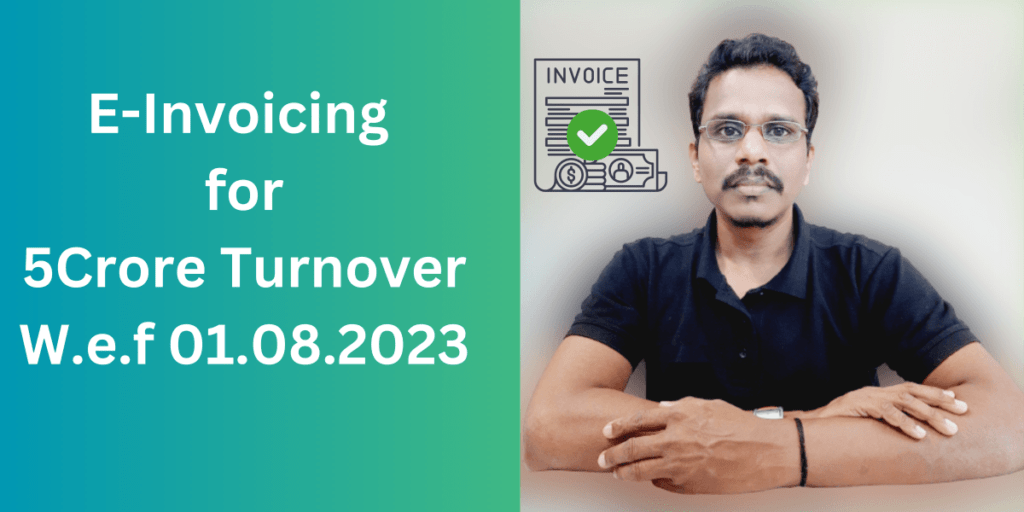If your business has a turnover of 5 crores or more, it’s time to switch to e-invoicing under GST. In this regard, the government issued a notification on 10th May 2023 having Reference no. No. 10/2023 –Central Tax. Therefore, as per this notification, e-invoicing becomes mandatory for businesses having a turnover of more than Rs. 5 crores w.e.f 01.08.2023. The turnover must be calculated on the PAN India base. The e-invoicing must be done for the GST-registered person supplying Goods and services to another business.
This digital invoicing system offers a range of benefits, from reducing errors and saving time to improving cash flow and simplifying tax compliance. In this post, we’ll explore the advantages of e-invoicing and provide tips on how to get started.

What is e-invoicing and why is it important?
E-invoicing is a digital invoicing system that allows businesses to create, send, and receive invoices electronically. It eliminates the need for paper-based invoices, reducing errors and saving time. E-invoicing also improves cash flow by speeding up the payment process and simplifies tax compliance by providing accurate and timely data. With the government mandating e-invoicing for businesses with a turnover of 5 crores or more, it’s important to make the switch now to avoid penalties and stay ahead of the curve.
Read here for more about the E-invoice system under GST
Benefits of e-invoicing for businesses.
E-invoicing offers numerous benefits for businesses, including increased efficiency, reduced errors, and improved cash flow. With e-invoicing, businesses can create and send invoices quickly and easily, without the need for paper-based systems. This reduces the risk of errors and delays and ensures that invoices are delivered and paid on time. E-invoicing also provides accurate and timely data, making it easier for businesses to comply with tax regulations and manage their finances. Overall, e-invoicing is a smart choice for businesses looking to streamline their invoicing processes and stay ahead of the competition.
How to get started with e-invoicing.
The e-invoice process involves creating invoice data in a specific format (JSON) using either ERP/business management software or an offline tool provided by the portal. This data is then uploaded to the IRP, which verifies and authorizes the invoice data with an IRN and QR code. This process streamlines invoicing and reduces the risk of errors or fraud.
Here is the step-by-step process
- To create an e-invoice, there are two options available. The first is to use software solutions or business management software to generate the invoice in a specific format. The second option is to use the offline tool provided by the portal. Either way, the e-invoice must be created according to the prescribed format.
- To submit an e-invoice, simply log in and upload the file to the IRP (Invoice Registration Portal). If your software is integrated with the IRP through a GSP (GST Suvidha Provider), the upload process will be automated. This means that the system will send the necessary details directly to the IRP portal, making the process even more streamlined.
- An e-invoice is a digital version of a traditional paper invoice that is validated through an IRP portal. This portal checks important invoice details and, if everything is correct, assigns an IRN number and QR code to authenticate the invoice data. This process helps to streamline invoicing and reduce errors.
- E-invoicing is a digital method of creating and sharing invoices. Once you upload your invoice, you will receive a file containing the e-invoice and its unique identification number (IRN). You can then update your invoice with the IRN and a QR code. If you are using an integrated ERP and IRP system via GSP, the software will automatically retrieve and print these details for you.
Read How to Register on E-invoice Portal?
Compliance requirements for e-invoicing.
In addition to the benefits of increased efficiency and improved cash flow, e-invoicing also comes with compliance requirements that businesses need to be aware of. The government has mandated e-invoicing for businesses with a turnover of 5 crore or more, and failure to comply can result in penalties and fines. It’s important to ensure that your e-invoicing solution is compliant with the government’s requirements and that you are following all necessary procedures. Your e-invoicing solution provider should be able to provide guidance on compliance and help you stay up-to-date with any changes in regulations. By staying compliant with e-invoicing requirements, you can avoid costly penalties and ensure the smooth operation of your business.
Future of e-invoicing in India.
E-invoicing is the future of invoicing in India, with the government pushing for its adoption to improve efficiency and reduce tax evasion. While currently only businesses with a turnover of 5 crore or more are required to use e-invoicing, it is expected that this requirement will be extended to smaller businesses in the future. By adopting e-invoicing now, businesses can stay ahead of the curve and be prepared for any future changes in regulations. Additionally, e-invoicing can provide businesses with valuable data insights and help streamline their invoicing processes, leading to increased productivity and profitability.

